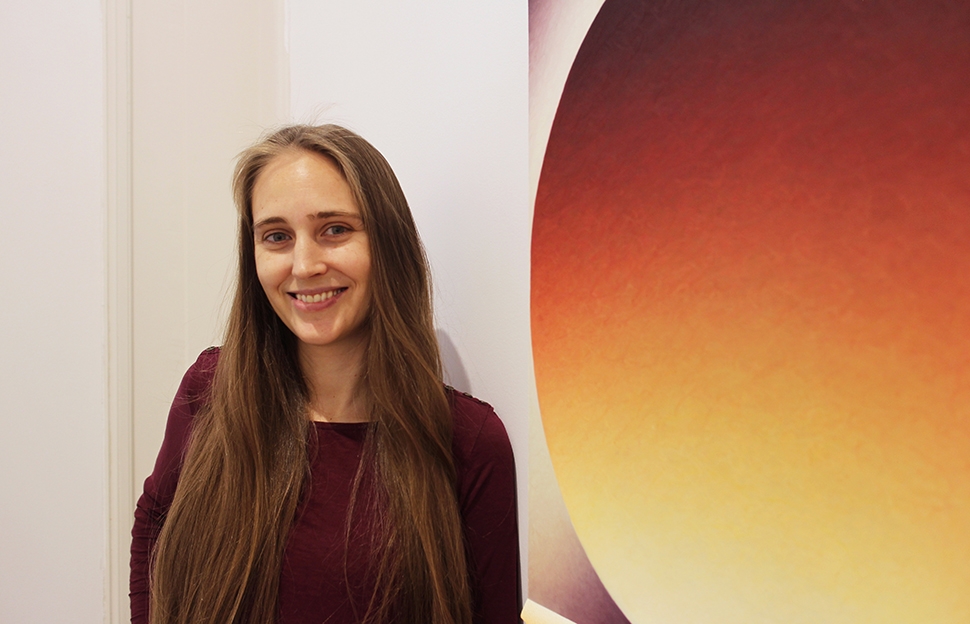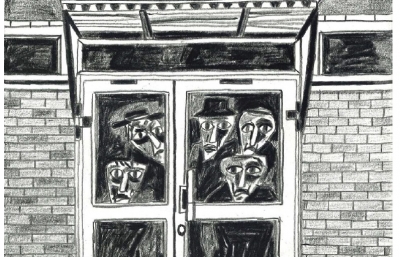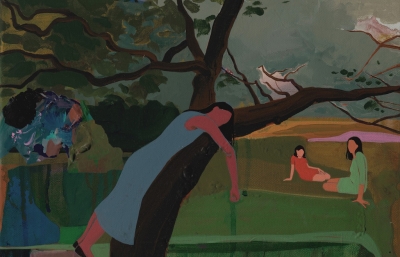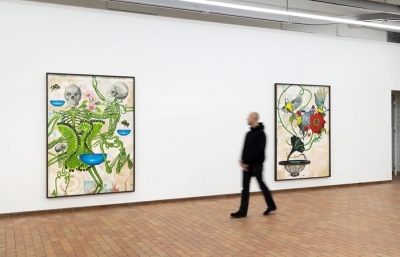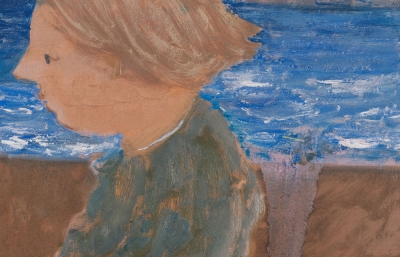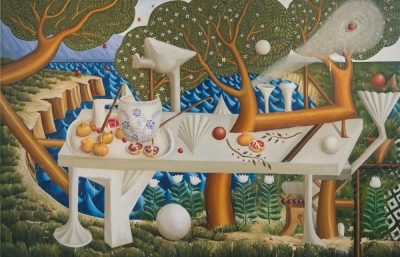Loie Hollowell
The Complexity of Symmetry
Interview and portrait by Sasha Bogojev
No matter how it’s defined, figuration is fascinating, whether formal and idealized, narrative or exaggerated. The merger of abstraction and figuration is exciting and challenging, so to this end, we just couldn't be indifferent to Loie Hollowell's elegant, radiant creations. Evolving from earlier works focused on female nudes, her newest imagery still alludes to the human form, with an emphasis on women’s bodies. Hollowell’s visual language elevates flat geometric components into a figurative, almost sculptural sphere through a fascinating approach to volume, surface and texture.
By layering high-density foam and sawdust on a panel, Hollowell builds the sophisticated shape of her work, which she finishes with a delicate but determined application of oil and acrylic. Breaking away from the flat surface creates seductive portrayals of bodily landscapes that evoke the mood of sacred iconography. Deceptively simple in their symmetric composition, complexity in the work is revealed in impeccable gradients, supple frangibility, intricate brushwork and pulsating colors. The compositions represent deep and personal narratives, speaking of intimate experiences and subjects such as sexuality, fertility and childbirth.
We sat down with the NY-based Hollowell ahead of her solo exhibition debut with GRIMM Gallery in Amsterdam, and dissected the work in her show, as well as a practice started less than five years ago, which has brought her immense international recognition and sold out shows with PACE in London and New York.

Sasha Bogojev: What was your motivation in shifting from figurative beginnings in grad school to more abstract work?
Loie Hollowell: There were a number of things. The first thing was that the person I was painting a lot was my ex-boyfriend, and then we broke up. Also, he didn't like that I was painting him while we were together, and I had painted a lot of sexual scenes. There was a lot of sexual aggression in the relationship, so I painted a lot, and I don't think he liked me expressing that in the work!
So from there, I took other figures out and just painted myself, self-portraits, and they became more and more stylized and cartoony. Then, as I moved through that process, I realized there was still so much more I wanted to say, expressionistically, less didactic. Like this figure is doing this, and this one is saying that. I wanted to figure out how to express deeper core emotions. How to make a painting of having your period or having an abortion or just very personal things that can't really be painted with the figure.
That's when I started moving into abstraction, when I was having these really crazy experiences with my body. I had an abortion. How do I paint that without painting a tube coming in? How do I make that more of an emotional painting rather than a descriptive painting?
That subject has not been covered much, right?
Those paintings, you would never look at them and say, "Oh, that's a painting of someone having explosive pain in their uterus." You would say, "Oh, that's like an abstract." They looked very much like Charles Burchfield, an American, upstate New York, a regional painter who made all these flowery landscape things. It looked more like an abstract landscape. So I didn't have to explain what this was about. It could be more open-ended for everyone.

How important is it for you that people know the content in advance, as opposed to approaching the pieces for how they appear?
Oh, it doesn't matter to me. It's all about making a phenomenological experience for someone. The work exists in a flat space on Instagram. I feel like it works. They’re colorful and very minimal geometric shapes that read a certain way. But when you see them in person, I really like that someone will have an experience with the dimensional space and the way that the textures of paint are put on. That's more important to me than them knowing, like, "Oh, this is a painting of the crowning of my son's head coming out of my vagina." That's for me; it may inspire me in the studio, but it doesn't have to inspire the viewer.
It feels like they're going against the grain in the sense that they are Instagrammable. But what you see on Instagram is actually a fraction of what they actually are.
It's like the surface, which is what Instagram is. That's what it does to everything, and I really like that. I got attention for my work, actually, because of Instagram. I have the same experience when I see something on Instagram, and I really love it. I'll reach out to the artist and say, "Can I come to your studio?" And sometimes you see the work and it's flat. It almost looks better as a digital image. But then, sometimes, you see the work and it's amazing! You're just like, "Oh, Instagram doesn't do it any justice."

Low Hanging Fruit, Oil, acrylic medium, sawdust, and high-density foam on linen over panel, 48" x 36" x 3", 2018
I had that experience with your work, even when I saw the photos from a certain angle and became aware they were dimensional.
The subtlety of the dimensionality is much more about the space between the viewer and the presence of the piece. You really have to get that subtlety in its presence, like, "Oh, you can see it's built out but it just looks silly." It looks almost little, almost not enough of something.
For me, your textures also play an important part with their twirly brushwork.
I don't know what was happening, but my cats were shedding a lot. The cat hair was getting in these paintings, and I just started putting the cat hair in the painting. So these are the first paintings and probably the only paintings where I'll ever put cat hair.
Is it in the description of the work, as well?
Yes, yes. It says, "Hair."

Do you have an idea of what motivates you to focus on your particular and personal themes?
This is what I’ve come to realize—it's like our world is politically motivated and there's just so much consciousness on speaking your truth and not trying to speak for someone else. But I found when I was making paintings of me and my ex, for example, I was speaking about him, rather than just speaking about myself. So I feel that by pulling from very specific parts of my life that are happening at the moment of making the paintings, that's what I know the best and that's where I can most speak the truth. People can come at me and say, "Well, that's not my experience of giving birth," but I can say, "Well, this is my experience." So there's some kind of like safety in it, as I'm not trying to make commentary on anyone else's body.
What is the process for conveying your emotions? Because those are very personal experiences.
It starts with trying, like I was saying, to make these sexual graphic cartoony sketches in my notebook, then abstracting that and making it more geometric, more abstract. And then finally taking it to the drawing and figuring out what colors need to be where in order to describe that element or emotion. It always comes from experience first.
Sometimes I don't even make a drawing. There's a shape or way that a shape works within a space that I know describes this feeling. So I'll reuse that and recompose it into the painting, like for Horizon on my Pit of Hell. I've used that bar at the bottom as a pedestal or the landscape, the ground that the subject sits on. I didn't need to sketch out how to make what's happening above that, because I knew it had to have this bed or landscape, some kind of space that's coming out. What I'm thinking of is when you're dilated. Like Guston had these paintings or he had all his little lexicon of shapes. He had the shoe and the nail, and each painting possessed one element of what he paints. It's like, in my head, I have the different elements that I paint, and sometimes it's just like, "Oh, that has to be in this painting to describe this."

I was wondering if other women shared their experiences or were able to identify or recognize these moments in some way?
The show at PACE was all my portraits. I thought of them as portraits, just single standing or sitting figures with all the same shapes, and six different shapes to describe different parts of my body. But for the ones in Amsterdam, I just dug into a very short timeframe of giving birth, so it's just my thing. I have those conversations with women. I know what my friends’ experiences are, where I felt like "a pit of hell" or "a burning fire pit." My good friend who just had a baby was like, "Oh no, no, it was like a bullet. It was like steel, a hard, impenetrable steel thing that I was stuck in." For me, it was just like burning.
I ask, from a male perspective, as a father who was present during the birth of his son, so I understand only to some extent.
But that's okay. What I enjoy most is having the conversation with someone who's just looking at them as just in their presence. I don't need you to know that that's my pit of hell painting, you know?

Is that something you do consciously, as in stimulating different readings? Do you intend them to radiate more levels, more possibilities because of their 3D aspect?
I'm really interested in hearing what people think about that. I mean, for me, it's so challenging to paint on a three-dimensional space. It's really fun, that's why I do it. But it's also just dealing with the light because when these are just white surfaces, shaped white surfaces, there's all kinds of shadows and stuff happening. So I'm trying to put paint onto something that's already a built-up space.
For me, I'm battling with the paintings, but I'm interested in how that's actually reading to other people. I've been doing the built-up stuff for four years now, but coming out into two inches is pretty new.
Did your practice feel too comfortable or too much of a routine that you felt compelled to make the switch, or how did that happen?
It was more that it just had to be sculpted. I guess it's not just necessarily routines, more that it just has to go this way. I make this shape a lot, I call it a mandorla, an almond shape, and I paint it as my vagina. So I was painting these, trying to render a sphere thing from a flat image. It’s like I just need to feel it. I need to feel the football, I need to feel the light, you know?

Prenatal Plumb Line (detail), Oil, acrylic medium, sawdust, and high-density foam on linen over panel, 72” x 54” x 3 1/2”, 2019
This is how they began?
I just got some molding paste and sawdust, mixed them together and sculpted it. Then my husband, after a year of doing that, he's like, "You're doing this way too slow. Here, do you know about this foam?" Then, within a month, I had, like, five paintings done. I was like, "Oh man!"
And you're even accenting their dimensionality with paint, right?
Yeah, that's letting me play with light more, as there's so much shadow, actual physical darkness, because of how the shapes are creating the shadows. I'm having to really push the white to make bright light.
But there are so many things you can do in that situation. How do you paint that space where there's actually darkness and you wanted to portray different energy? It's just so open-ended. As a painter, you're just used to paint, making everything out of nothing. With this, you're making something out of something that already exists.
Some feel as if they're literally glowing. Did you ever consider incorporating light or anything like that, say, going more technical?
Well, I come from California, where the Light and Space movement is, you know, central. You grow up reading all about Robert Irwin and James Turrell, and all the light and space people of the ’60s, ’70s, and ’80s. They're about fluorescent lights, and natural light, and any way you can manipulate light. I guess that’s what I really love about painting, and I think I learned this from my dad, who went to the Netherlands to study Pieter de Hooch and Vermeer, and the way that you can manipulate light paint. I guess that's always been so fascinating and challenging, and there's something about it that I'm just grounded to making in paint, not in reality. I'm open to fucking up every other element of painting. The idea of painting light, I'm really stuck to.

From the Beginning (inversed), Oil, acrylic medium, sawdust, and high-density foam on linen over panel, 48" x 36" x 2", 2017
When we spoke about the show coming up in Amsterdam, you mentioned spending some time here as a baby, and you named people that informed your work in a way.
Roland Schimmel, for one. He's such a conceptual thinker, but, ultimately, his works become these phenomenal logical experiments where, when closing your eyes and then opening them after seeing the image, you kind of see the light spots, the image spots. The kind of blurred things of color, blurred circles of color. So all of his room installations have to do with the really subtle shifts in the structure of how your eye works. Then Kinke Kooi kind of does what I'm too afraid to do, which is really just bodily, intestinal, sensual, sexual figurative drawings. There are breasts and nipples, so beautiful and very saturated with this superabundance of the feminine and sensuality. That's how her drawings are.
Do you have an idea of how their work might have influenced you?
I think I've gone more into embracing the part of talking about the work. I used to not talk about it, but was just like, "They are formal," even though that's where it came from, but I wasn't talking about it like that. I guess Kinke Kooi definitely helped me think how this is something that can be addressed, even if I'm not doing it explicitly on the canvas. But they're both so amazing, and I think Kinke, like so many women, is getting deserved attention as she's gotten older, having shows in the U.S. here and there. She's definitely an underappreciated female artist.

Let’s talk more about how you fixate on capturing the light with paint.
You know Mary Weatherford's work, who shows with Gagosian? She makes these large, loose, abstract, gestural paintings and hangs a fluorescent light on them. They're beautiful, and I love them. I think how I would paint that. There's just something fun and challenging. I love adding the sculptural element and fucking with the reality of light, having to control the actual light and shadow with paint.
Do you like imposing challenges on yourself?
Yeah. I like doing that. Like with my system of forms, as I said, that is only going to come from my own body and my own experience. I'm going to work with the formal content of geometry and symmetry. I've decided to really put limits on what and how I paint. Within that, though, I like to give myself challenges, like, how far can I make the forms come out? That's where I really want to go in sculpture, but then trying to keep those same elements of painting that I like. How do I deal with light, controlled and painted within a fully sculptural space? I haven't figured that out yet.

Dominant / Recessive, Oil, acrylic medium, sawdust, and high-density foam on linen over panel, 48" x 36" x 3 1/4", 2018
I read in some interviews that you're not especially fond of the term abstract?
Well no, I don't mind the term abstract. It's just very... it has such an open meaning. In America, you have the Abstract Expressionism movement, which really dominates the idea of abstraction. I don't know, I'm not an art historian, and I can't give a long description of what the history of abstraction is, but for me, these works are portraits of certain experiences. So, in that way, they're not abstractions. But I understand that they read as abstract.
Honestly, I don’t always relate to abstraction. But, with your work, with the composition, those surfaces and textures, and the underlying story, it all just makes sense. It really feels like figurative work while looking 100% abstract.
Yeah, because the way I compose it is much more in that space. I plan out the image, I make a sketch, I make a pastel, and then I make the painting. I'm thinking about each element in the painting as a part of the body or a place in space, like real space, in the landscape.
When I think of abstraction is where I get into trouble. When I talk with real art historians, I think of abstraction as taking a brush and moving your arm, and it's all loose, and all about the gesture and being in the present; whereas mine are super planned out. I almost know how it's going to look before I begin the painting, with these very subtle changes that happen between the drawing and the finished painting. I guess I don't think of that as abstract.

Dead End, Oil, acrylic medium, sawdust, and high-density foam on linen over panel, 48" x 36" x 3 1/4", 2018
Looking at the surfaces and talking about this form, I see how you utilize a lot of new or unconventional materials. How do you research the process?
I know about this stuff because my husband's a sculptor. For example, there’s a material that Fischli/Weiss use. They're sculptors who make trompe l'oeil sculptures. Basically, they make a sculpture that looks like something else, but is made out of this foam, which is known throughout the sculptural world as a really long-lasting material. It's also nice because, with the new CNC machines that have automated control of tools, it can be milled. It's basically as dense as wood, but cheaper.
Your work looks perfect and symmetrical. But from how you explain it, it appears very manual, actually analog?
Kind of. The drawings themselves, I'm trying to make perfect, but they're not. When I take pictures, and give them to the person who takes it into the program to make it rendered, they use vectors and machines. That gets printed out, or maybe it gets milled, and then it gets sanded by hand again and then the hand returns and covers the foam with an eggshell thickness of an acrylic product called molding paste. That acts as a barrier for the foam, for the paint to sit on. As that gets applied, they can be reshaped and sometimes they become less symmetrical again. But pretty much it's like a very proportional outcome because they're being printed or milled.

Standing in Water, Oil, acrylic medium, sawdust, and high-density foam on linen over panel, 72” x 54” x 3.5”, 2019
But there is a whole idea about making that imperfect symmetry, right?
For me, it always began with the symmetry of the body because I started painting one area and then moved to another area. Again, this is an area of my body. That's just a really hard question to answer because it's just so natural. I'm always looking at myself from the front. I've never looked from the side. I can look in the mirror this way, but I just always thought about these spaces as looking at myself from a frontal point of view.
When you were doing more figurative work, was it about balance, too?
No, not at all. I did make a lot of symmetrical drawings over the years. I had this whole series where I would draw half of my face with charcoal, and then fold the paper and press it. So then you'd have the symmetrical, weird, distorted face. That was years ago, before grad school, but there have been things of symmetry in thinking about my body. The distorted nature of what happens when you look at one side and try to copy it again. It's not always perfect when you try to copy this to the other side, so it's almost second nature right now. I don't have language to describe the reasons for symmetry.
Do you have a kind of dream project that you would like to realize?
I have a few dream pieces I want to make, one I've had in mind over the past few months. I want to make like some kind of bas relief. I basically want to think of these things as sculpture in the larger setting, and have large wall-sized objects that really blur the line of sculpture and painting, with maybe an element of water happening, like trickling down inside the shapes or something. I want there to be some kind of puzzle, or maybe these shapes kind of manipulate how water falls… something like that.

